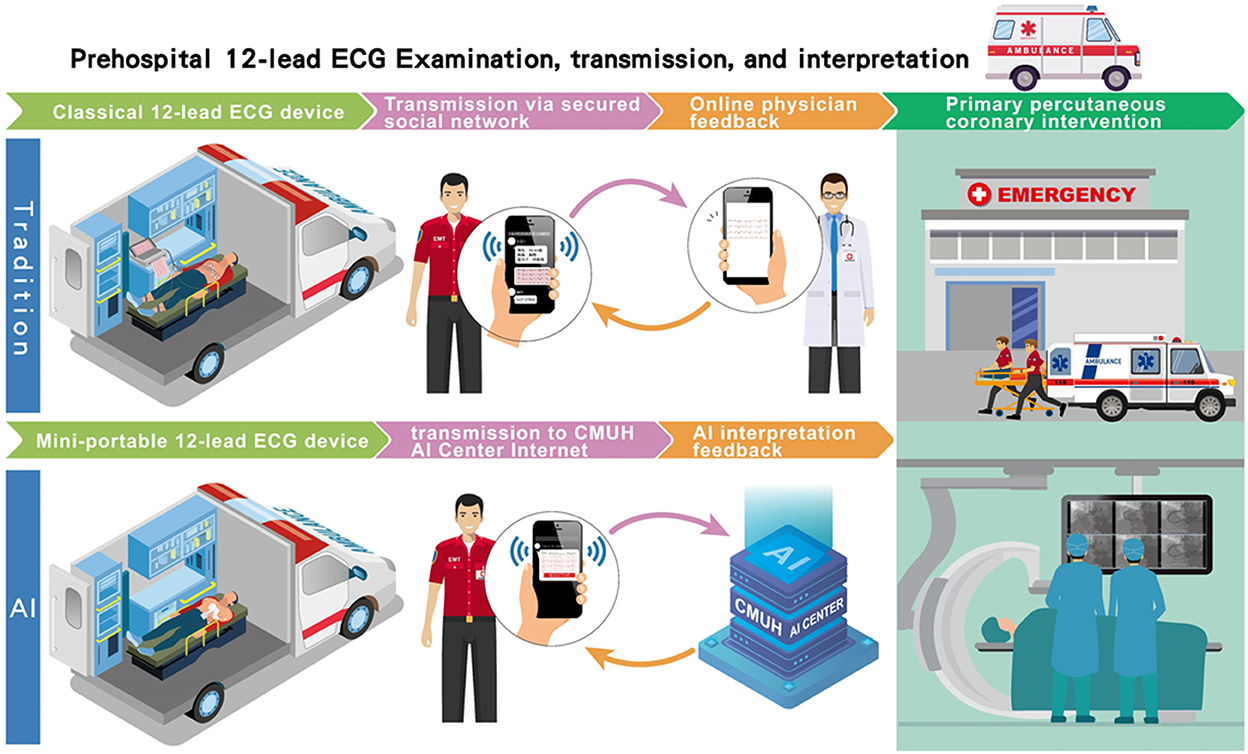Corrigendum: Artificial intelligence-assisted remote detection of ST-elevation myocardial infarction using a mini-12-lead electrocardiogram device in prehospital ambulance care
- 1Division of Cardiovascular Medicine, Department of Medicine, China Medical University Hospital, Taichung, Taiwan
- 2Graduate Institute of Biomedical Sciences, China Medical University, Taichung, Taiwan
- 3Division of Cardiovascular Medicine, Asia University Hospital, Taichung, Taiwan
- 4Department of Medical Laboratory Science and Biotechnology, Asia University, Taichung, Taiwan
- 5AI Center for Medical Diagnosis, China Medical University Hospital, Taichung, Taiwan
- 6School of Post-Baccalaureate Chinese Medicine, China Medical University, Taichung, Taiwan
- 7Department of Chinese Medicine, China Medical University Hospital, Taichung, Taiwan
- 8Ever Fortune AI Co., Ltd., Taichung, Taiwan
- 9School of Medicine, China Medical University, Taichung, Taiwan
- 10Institute of Biomedical Sciences, Academia Sinica, Taipei, Taiwan
- 11Center of Institutional Research and Development, Asia University, Taichung, Taiwan
by Chen, K.-W., Wang, Y.-C., Liu, M.-H., Tsai, B.-Y., Wu, M.-Y., Hsieh,P.-H., Wei, J.-T., Shih, E. S. C., Shiao, Y.-T., Hwang, M.-J., Wu Y.-L., Hsu, K.-C., and Chang, K.-C. (2022). Front. Cardiovasc. Med. 9:1001982. doi: 10.3389/fcvm.2022.1001982
In the original article, there was an error in Figure 1: “The flowchart of the AI-based pre-hospital STEMI detection system” as published. A typo error in the figure read “Prehospital 12-lead ECG examinectin,” and has been corrected to “Prehospital 12-lead ECG examination.” The corrected figure appears below.

Figure 1. The flowchart of the AI-based pre-hospital STEMI detection system. Traditionally, after the 12-lead ECG had been recorded in the ambulance vehicle, the ECG data were posted on a secured network for reading by available online physicians as had been usual practice. The time interval between ECG transmission and interpretation feedback by physicians was defined as the physician's response time. In our AI-based pre-hospital STEMI detection system, the recorded signal was also simultaneously transmitted to the AI center of the China Medical University Hospital to be classified “STEMI” or “Not STEMI.” Similarly, the time interval between the ECG transmission and the ECG interpretation feedback by the AI was defined as the AI's response time.
The authors apologize for this error and state that this does not change the scientific conclusions of the article in any way. The original article has been updated.
Publisher's note
All claims expressed in this article are solely those of the authors and do not necessarily represent those of their affiliated organizations, or those of the publisher, the editors and the reviewers. Any product that may be evaluated in this article, or claim that may be made by its manufacturer, is not guaranteed or endorsed by the publisher.
Keywords: artificial intelligence (AI), contact-to-balloon (C2B) time, convolutional neural network and long short-term memory (CNN-LSTM), prehospital 12-lead ECGs, ST-elevation myocardial infarction (STEMI)
Citation: Chen K-W, Wang Y-C, Liu M-H, Tsai B-Y, Wu M-Y, Hsieh P-H, Wei J-T, Shih ESC, Shiao Y-T, Hwang M-J, Wu Y-L, Hsu K-C and Chang K-C (2022) Corrigendum: Artificial intelligence-assisted remote detection of ST-elevation myocardial infarction using a mini-12-lead electrocardiogram device in prehospital ambulance care. Front. Cardiovasc. Med. 9:1078223. doi: 10.3389/fcvm.2022.1078223
Received: 24 October 2022; Accepted: 24 November 2022;
Published: 09 December 2022.
Edited and reviewed by: Roohallah Alizadehsani, Deakin University, Australia
Copyright © 2022 Chen, Wang, Liu, Tsai, Wu, Hsieh, Wei, Shih, Shiao, Hwang, Wu, Hsu and Chang. This is an open-access article distributed under the terms of the Creative Commons Attribution License (CC BY). The use, distribution or reproduction in other forums is permitted, provided the original author(s) and the copyright owner(s) are credited and that the original publication in this journal is cited, in accordance with accepted academic practice. No use, distribution or reproduction is permitted which does not comply with these terms.
*Correspondence: Kuan-Cheng Chang, kuancheng.chang@gmail.com
†These authors have contributed equally to this work
 Ke-Wei Chen1,2†
Ke-Wei Chen1,2†  Mei-Yao Wu
Mei-Yao Wu Ming-Jing Hwang
Ming-Jing Hwang Kuan-Cheng Chang
Kuan-Cheng Chang